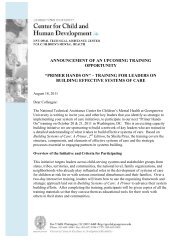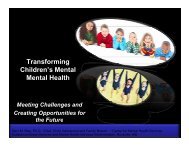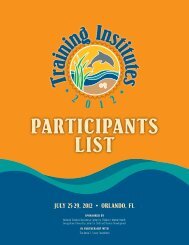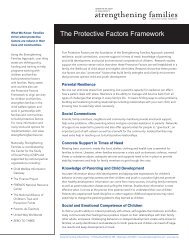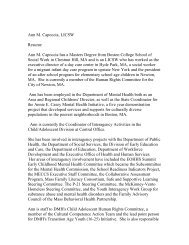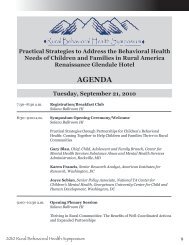Training Institutes 2012 - National Technical Assistance Center for ...
Training Institutes 2012 - National Technical Assistance Center for ...
Training Institutes 2012 - National Technical Assistance Center for ...
Create successful ePaper yourself
Turn your PDF publications into a flip-book with our unique Google optimized e-Paper software.
RESOURCES<br />
Definition of Cultural and<br />
Linguistic Competence<br />
Definition of Cultural Competence<br />
There is no one definition of cultural competence. Definitions of cultural competence have evolved from diverse<br />
perspectives, interests, and needs and are incorporated in state legislation, Federal statutes and programs, private sector<br />
organizations, and academic settings. The seminal work of Cross et al in 1989 offered a definition of cultural<br />
competence that established a solid foundation <strong>for</strong> the field. Cultural competence is a set of congruent behaviors,<br />
attitudes, and policies that come together in a system, agency, or among professionals and enable that system, agency or<br />
those professions to work effectively in cross-cultural situations.<br />
The word culture is used because it implies the integrated pattern of human behavior that includes thoughts,<br />
communications, actions, customs, beliefs, values, and institutions of a racial, ethnic, religious, or social group. The<br />
word competence is used because it implies having the capacity to function effectively.<br />
Five essential elements contribute to a system’s, institution’s, or agency’s ability to become more culturally<br />
competent which include:<br />
1. Valuing diversity<br />
2. Having the capacity <strong>for</strong> cultural self-assessment<br />
3. Being conscious of the dynamics inherent when cultures interact<br />
4. Having institutionalized culture knowledge<br />
5. Having developed adaptations to service delivery reflecting an understanding of cultural diversity<br />
These five elements should be manifested at every level of an organization including policy making, administrative, and<br />
practice. Further these elements should be reflected in the attitudes, structures, policies, and services of the organization.<br />
Definition of Linguistic Competence<br />
Definitions of linguistic competence also vary considerably, and are incorporated into state legislation, Federal statutes<br />
and programs, private sector organizations and academic settings. The following definition, developed by the <strong>National</strong><br />
<strong>Center</strong> <strong>for</strong> Cultural Competence, provides a foundation <strong>for</strong> determining linguistic competence in health care, mental<br />
health, and other human service delivery systems.<br />
Linguistic Competence is the capacity of an organization and its personnel to communicate effectively, and convey<br />
in<strong>for</strong>mation in a manner that is easily understood by diverse groups including persons of limited English proficiency,<br />
those who have low literacy skills or are not literate, individuals with disabilities, and those who are deaf or hard of<br />
hearing. Linguistic competency requires organizational and provider capacity to respond effectively to the health and<br />
mental health literacy needs of populations served. The organization must have policy, structures, practices, procedures,<br />
and dedicated resources to support this capacity. This may include, but is not limited to, the use of:<br />
• Bilingual/bicultural or multilingual/multicultural staff<br />
• Cross-cultural communication approaches<br />
• Cultural brokers<br />
• Foreign language interpretation services including<br />
distance technologies<br />
• Sign language interpretation services<br />
• Multilingual telecommunication systems<br />
• Videoconferencing and telehealth technologies<br />
• TTY and other assistive technology devices;<br />
• Computer assisted real time translation (CART) or<br />
viable real time transcriptions (VRT;<br />
• Print materials in easy to read, low literacy, picture and<br />
symbol <strong>for</strong>mats<br />
• Materials in alternative <strong>for</strong>mats (e.g., audiotape,<br />
Braille, enlarged print)<br />
• Varied approaches to share in<strong>for</strong>mation with<br />
individuals who experience cognitive disabilities<br />
• Materials developed and tested <strong>for</strong> specific cultural,<br />
ethnic and linguistic groups<br />
• Translation services including those of: legally binding<br />
documents (e.g., consent <strong>for</strong>ms, confidentiality and<br />
patient rights statements, release of in<strong>for</strong>mation,<br />
applications); signage; health education materials;<br />
public awareness materials and campaigns; and ethnic<br />
media in languages other than English (e.g., television,<br />
radio, Internet, newspapers, periodicals)<br />
Developed by Tawara D. Goode and Wendy Jones, 8/00, Revised 8/03, 9/08, 3/10.<br />
164 <strong>Training</strong> <strong>Institutes</strong> 2010



